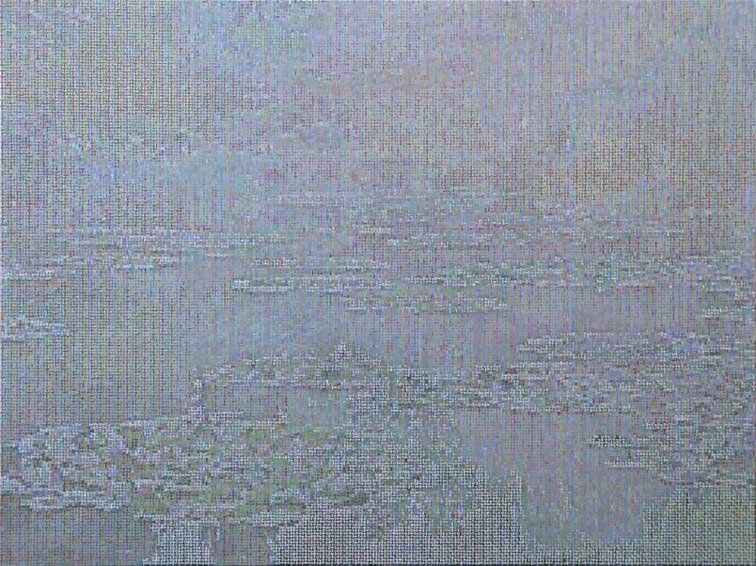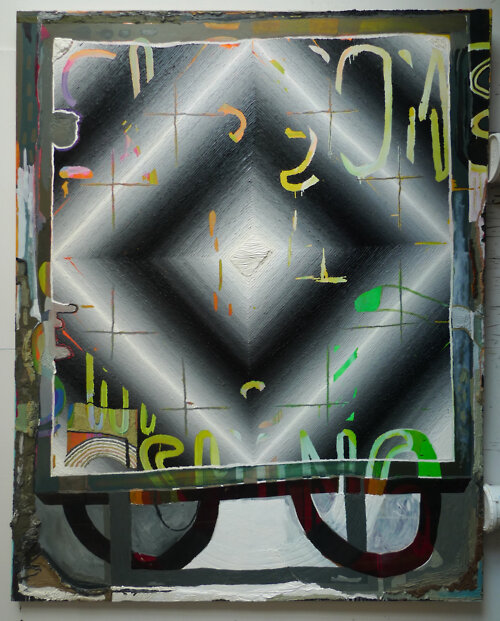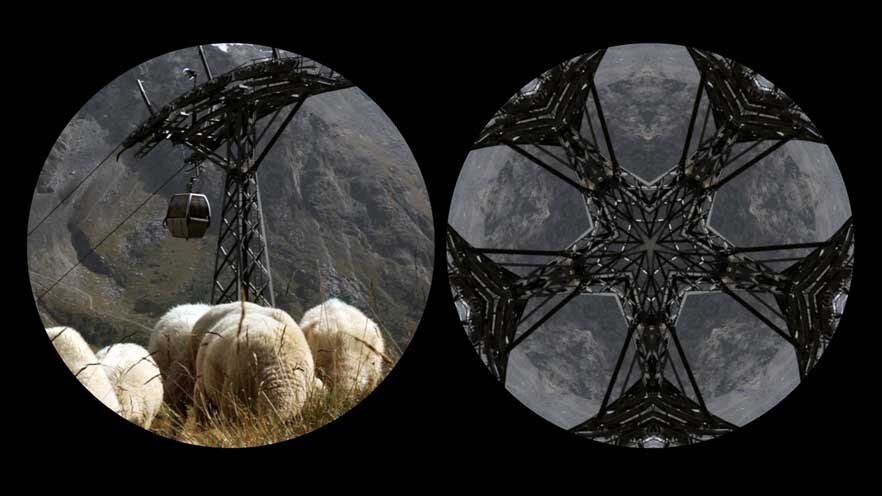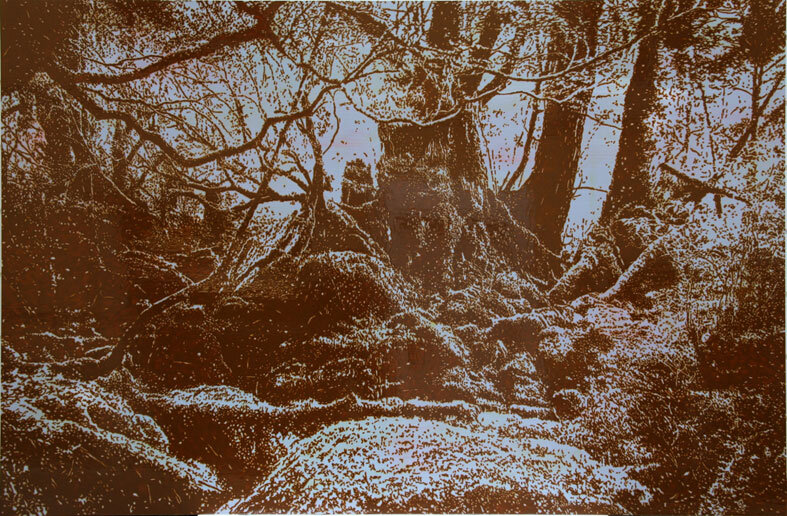



PARIS
Techno Nature
September 1 - October 13, 2012
The representation of nature acts to replace « the open window on the world » --- which has been the veduta of the painters for the past 4 centuries. Today, the computer screen, with its connected networks and internet websites, does the same. But, painting has not disappeared, rather, it withdrew ; whether it remained on the surface of the canvas as a medium, or it acquired a virtual and dematerialized dimension. Techno Nature showcases four « points of view » --- going from the canvas to the screen, or vice versa.
Using low-resolution images of landscapes gleaned from the Internet, Dan Hays constructs paintings with connections to the history of landscape painting, (even if not explicit), and in turn presents a paradoxical visual realm where immaterial pixels and physical brushstrokes coalesce. His work speaks to how accustomed we’ve become to living with or seeing screens, and also how alarming and disheartening that is. « Not just in the cinema or living room, but on mobile telephones, advertising hoardings and computer interfaces, the hi-tech screen threatens to mask an elemental experience of the world with a transparent optical illusion ». Shown to be a latent quality of any fugitive frame of YouTube video or traffic webcam, these images tend towards abstraction, suggesting a broader sense of longing for something lost.
The new series Binoculars by Leslie Thornton also shows a tendency towards abstraction. Thornton intersects nature and technology---the work consists of flat screen monitors where two circular fields appear on each : on the left, images of animals – birds, reptiles, fish, some exotic, others familiar – filmed in the wild, and on the right, the image is folded back on itself in a centripetal pattern, reminiscent of a kaleidoscope. The two circular fields are intimately connected. The effect is unexpected and profound. Nature is not subsumed, circumscribed or contained but the space of otherness traced in the image of the animals is filled by an abstract artificiality, transporting the viewer into a world prior to language.
Michel Huelin deals with the concept of a transformed, alienated nature, with manipulation and mutation. In a series of Lambda prints and videos he presents digital creations of a virtual biotope (or Phytotron) in which the elements complement and nurture each other. The viewer plunges in a fictious ecosystem, a jungle of hybrid objects half familiar half alien. En découvrant ce monde sans échelle, l’œil prospecte, pris entre plaisir et vertige, bulles et explosions, épouse transparences et distorsions. « To a certain extent, Huelin explains, I simulate a possible evolution of living and inert matter by changing a number of numerical parameters that determine the reactions between the virtual elements and their fictive environment. »
Paul DeMuro’s new paintings utilize a computer or even a cell phone to change the image on the screen into its photographic inverse. By using color that is removed from intuition and then translating into physical, thick, sculptural oil paint, he attempts to deal with this specific moment in the relationship between the human hand and the machine : « Would it not be hard to imagine the day when a program will arrive that makes your posts, pics, tweets, likes, etc. into a repeating algorithm, thus making your personality, persona and identity go on into the foreseeable future, long after your body dies and rots away ? »
Bernard Zürcher
L’aphorisme bien connu d’Aristote "la nature a horreur du vide" a la vie dure alors qu’il repose sur une idée fausse. Descartes imaginait un monde peuplé de tourbillons de matière et Pascal, dans ses Expériences nouvelles touchant le vide mit en évidence "la pression de l’air". Il fallut attendre Rutherford en 1911 pour comprendre que la matière elle-même est composée de vide à 99,999…%, chose inconcevable sinon en termes d’échelle. L’infiniment petit des atomes comme l’infiniment grand de l’univers galactique reposait ainsi sur un paradoxe : le caractère immatériel de la matière. Ce modèle ne pouvait qu’affecter les modes de représentation de la nature longtemps gouverné par celui de "la fenêtre ouverte sur le monde", la veduta des peintres depuis la Renaissance italienne et aujourd’hui l’écran des ordinateurs puis ceux des téléphones portables connectés aux réseaux et aux sites internet. L’exposition Techno Nature privilégie ainsi plusieurs « points de vue » de la toile à l’écran proposés par Dan Hays, Michel Huelin, Leslie Thornton, et Paul DeMuro.
Dan Hays construit son tableau à partir d’un choix d’images basse définition prélevées sur internet – avec des références plus ou moins explicites à l’histoire de la peinture de paysage – en élaborant un mode de représentation visuelle basé sur un paradoxe associant l’immatérialité du pixel à la dimension physique de la touche picturale. Son œuvre souligne la dépendance toujours plus étroite de notre regard incapable de regarder la nature en face sinon par l’intermédiaire des écrans hi tech qui envahissent toujours un peu plus notre quotidien. Ecrans « fugitifs » engendrés par le trafic webcam, ces images « intelligentes » induisent la mise en abîme d’une représentation abstraite de la nature.
La série des Binoculars de Leslie Thornton conduit également à l’abstraction. Dans l’œuvre de Thornton nature et technologie interfèrent. Deux champs circulaires apparaissent côte à côte sur l’écran d’un moniteur. Dans celui de gauche des animaux exotiques ou familiers ont été filmés dans leur cadre habituel tandis que dans celui de droite leur image a subi un traitement expérimental de manière à former un pattern centripète comme le ferait un kaléidoscope. Les deux champs circulaires qui forment cette lunette virtuelle sont intimement liés de sorte qu’un mouvement perpétuel effectue le passage de l’un à l’autre. L’effet est saisissant car le spectateur assiste à une « atomisation » du sujet transformé soudain en un pur système sémantique.
Michel Huelin joue également sur le concept de « transformation » en créant l’image d’une nature ayant subi de nombreuses hybridations et mutations, parfois « contre-nature ». Après des créations digitales aboutissant à des images lambda-print et video, il a repris la peinture en associant le tracé manuel au pinceau à la matière hautement technologique des résines alkydes. En découvrant ce monde sans échelle, l’œil du spectateur plonge dans un écosystème régi par l’indétermination entre les dimensions macro et microscopiques, comme par l’indéfinition entre le « naturel » et l’ « objectif ».
Les peintures de Paul DeMuro constituent une application logicielle basée sur le principe d’inversion de l’image photographique. Par un usage intuitif de la couleur mise en relief dans la pratique d’une peinture en épaisseur quasiment sculpturale, DeMuro cherche à mettre « la relation humaine » en connexion avec la machine. Pour lui, « le jour n’est pas si lointain où un programme informatique sera capable de reproduire ces messages les plus intimes – posts, pics, tweets, etc – qui définissent notre identité sous la forme d’un algorithme dont la répétition à l’infini nous fera exister bien après que nous ayons disparu corps et bien. »
Bernard Zürcher
Dan Hays (né en 1966, vit à Londres). Diplômé du Goldsmith’s College (1990) et de la Kingston University (2012) de Londres, il remporte le John Moores Prize en 1997. Expositions (sélection) : 2012 Viewfinder, Carter Presents, Londres (en cours) ; Untitled Repetition, curated by Fieldgate, Angus Hughes Gallery, Londres ; Ha Ha - What Does This Represent ? Standpoint Gallery, Londres ; Techno Nature, Zürcher Studio, New York, NY - 2011 Screen as Landscape*, Stanley Picker Gallery, Kingston University, Londres ; Like Paint, with Peter Klare, LoBe, Berlin – 2009 Failing Light*, Zürcher Studio, New York, NY – 2008 End Game — British Contemporary Art from the Chaney Family Collection, Museum of Fine Arts, Houston – 2007 In Monet’s Garden – The Lure of Giverny, Columbus Museum of Art, Ohio, USA ; Musée Marmottan, Paris ; Across the Water*, The Nunnery, Londres. Il est représenté par la galerie Zürcher, Paris-New York.
Michel Huelin (né en 1962, vit à Genève). Après des études de sciences naturelles, il sort diplômé de l’Ecole Supérieure des Arts Visuels de Genève (1988).
Expositions (sélection) : 2012 Techno Nature, Zürcher Studio, New York, NY ; Art Los Angeles Contemporary, Los Angeles – 2011 Alkyd & Pixels*, Blancpain art contemporain, Genève – 2010 Alkyd & Pixels*, Galerie Zürcher, Paris – 2009 Phytotron*, Fabian & Claude Walter Galerie Zürich ; Uncontrolled Growth II*, Zürcher Studio, New York ; Nature en Kit, MUDAC, Lausanne – 2008 Floating Device*, Museum of Contemporary Art, Cleveland ; Uncontrolled Growth*, Zürcher Studio, New York, NY. Il est représenté par la galerie Zürcher, Paris-New York.
Leslie Thornton (née en 1951, vit à New York, NY). Expositions récentes (sélection) : 2012 Radical Symmetry*, Elisabeth de Brabant Gallery, Shanghai, China ; Momenta Art, "Video 2012", New York, NY ; Techno Nature, Zürcher Studio, New York, NY - 2011 Leslie Thornton*, Winkleman Gallery, New York, NY ; Radical Light Program, MOMA, New York, NY ; Moscow Museum of Modern Art, Russie ; Tate Modern, London - 2010 Decalogue : Films You Can Count on Two Hands*, Winkleman Gallery, New York, NY. Les films, les vidéos et les installations de Leslie Thornton ont été exposés dans le monde entier, notamment à New York (Museum of Modern Art, Biennale du Whitney Museum, New York Film Festival) et en France (Centre George Pompidou, Paris ; CAPC, Bordeaux), mais aussi au Rotterdam International Film Festival, à la Pacific Film Archives de Berkeley et aux festivals de Oberhausen, Graz, Mannheim, Berlin, Austin, Toronto, Tokyo et Séoul, entre autres. En France, son oeuvre figure notamment dans les collections du Jeu de Paume et du Centre Pompidou. Elle est représentée par la Winkelman Gallery à New York.
Paul DeMuro (né en 1981, vit à Brooklyn, NY). Il est diplômé de la Temple University de Philadelphie (2007) et de la Rutgers University, NJ (2010). Il a obtenu en 2012 le Purchase Prize de l’American Academy of Arts and Letters. Expositions (sélection) : 2012 (à venir) Zürcher Studio*, New York, NY ; Techno Nature, Zürcher Studio, New York, NY ; Broken Window Plane, Tracy Williams ltd, New York, NY ; Rutgers MFA Open Studios, Mason Gross*, New Brunswick, NJ ; Mythografia, Bull and Ram, New York, NY – 2011 Bleach (with Alex da Corte), Jolie Laide, Philadelphia, PA ; In Between the Sheets, Harlem Workspace Gallery, New York, NY ; Exprist, Columbia University, New York, NY – 2010 De-Nature, Jolie Laide, Philadelphia, PA ; Off The Map, White Box, New York, NY. Il est représenté par la galerie Zürcher, Paris-New York.
